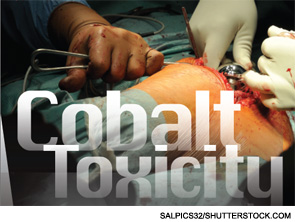
This year’s international story of cobalt toxicity occurring from metal wear after total hip replacement surgery was first broken during a session at the ACR Winter Symposium on Jan. 29, 2014: A Diagnosis Out of the Blue by Robert D. Bunning, MD, FACP, FACR. Shortly after the symposium, in early February 2014, The New England Journal of Medicine1 and The Lancet2 published similar case studies within days of each other, and the story was picked up by CBS3 and The New York Times.4 To further add to the story’s acclaim, Juergen Schaefer, MD, one of the authors of The Lancet article, explained that the inspiration for the final diagnosis in his case was thanks to his recollection of a 2011 episode of House M.D.5 The episode starred Hugh Laurie as Dr. House and Candice Bergen as his ailing patient, who was diagnosed with heavy metal poisoning caused by her prosthetic hip.
Cobalt poisoning from hip prosthesis is rare but debilitating. It’s caused when the metal wears and introduces cobalt into the bloodstream. This is a known risk with metal-on-metal implants, but newer data are showing that it is also a risk with metal-on-polyethylene implants. According to Dr. Bunning, associate medical director at MedStar National Rehabilitation Hospital in Washington, D.C., it’s important for rheumatologists to recognize the symptoms of cobalt toxicity—including cardiomyopathy and thyroid issues—in patients who have prosthetic joints. Cobalt toxicity can lead to devastating effects, but if it is caught early enough and revision surgery is performed to remove the metal prosthetic, damage can be reversible.
Case Studies
Three different case studies of cobalt toxicity after hip replacement surgery were presented within 10 days of each other in early 2014. The remarkable nature of these case studies is that “hip pain was not a prominent feature,” Dr. Bunning says. The patients did present with similar symptoms, and all were found to have excessively high serum cobalt levels. Two of the cases involved metal-on-polyethylene implants, and one involved a metal-on-metal implant. The diagnoses of cobalt poisoning and subsequent revision surgery occurred in varying degrees of time for each patient, which led to differing outcomes.
Case 1
The case that Dr. Bunning presented to the ACR involved an 81-year-old man who underwent a left total hip surgery in 2005 and a right total hip surgery in 2006. The patient’s implants were metal-on-polyethylene systems.

